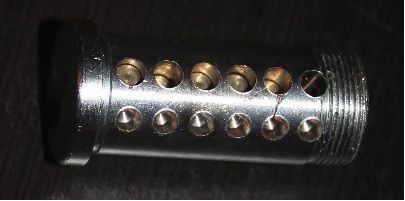
This plug is from a low-end key-in-knob lock, which was part of a deadbolt. I forget what manufacturer, but I think it may have been Weiser or a clone, the keyway is definitely Weiser (WR4 fits perfectly).
I had picked it a few times clockwise, and reset the pins with no trouble at all. I picked it once or twice counter-clockwise, and then one time, I picked it and it turned maybe 30 degrees, and jammed. It wouldn't turn, unless I exerted a lot of tension. I suspected I somehow got a spring stuck between the plug and the shell, but I couldn't figure out how. I figured one of the stacks must be really short, and the spring protruded into the plug (happened to me a few times in my first picking experiences with really cheap locks).
I tried resetting it, and re-picking it, but no matter what I did it refused to work properly. I put it aside for quite some time.
Now, having more experience, I finally decided to take it apart and examine it. I picked it again, and managed to turn it a few degrees, and then through brute force managed to take it apart with a plug follower... I obviously tore up a spring pretty bad, but all-in-all the rest of the lock seemed unhurt.
To my surprise, I saw that next to the pin chambers, was a second row of chambers, slightly smaller in diameter. I measured some of the pin stacks, and the fifth stack (key and top pins) doesn't need to be picked in order for the plug to turn. The two pins together perfectly fill the pin chamber, which allowed me to pick the lock by simply ignoring the fifth pin (at least, the time I screwed it up, it appears I ignored to fifth pin). It's possible that the fit was tight enough that when I picked clockwise, the spring did not get trapped, since I hadn't turned the plug 360 degrees. When I picked the other direction, my spring dropped into this second small chamber, and jammed the lock. (You can see where the spring marked the plug a little when I forced it).
You can see that these chambers are not very deep, which would make the spring protrude into the shell. However they are not large enough for the top pins to fit into them.
Luckily I follow the rules and don't pick locks that are in use. Had this lock been on my, or a friends door, I would have created a serious problem, and at the time I would not have known how to resolve it.
Anyone know another reason for these smaller chambers? (aside from trapping springs)
I was particularly surprised because it was such a cheap lock. I thought it seemed unlikely that it would incorporate pin, or spring, trapping chambers (I haven't yet gotten the chance to put my hands on a real lock with trap chambers...aside MAYBE this one).
Aside from a trap, I guessed they could also be used in some, time-saving, manufacturing process, in order to load the springs into the proper chambers. One could, I suppose, load the springs into these chambers, and the top pins into the key chambers of the plug. Push the springs down, as you insert the plug into the shell, one-by-one (keeping the shell upside down). Turn the "spring chambers" to the bible, and let gravity drop them into the chambers. Then turn 30 degrees more and let gravity drop the top pins into the bible. Insert a blank, and using a plug follower, remove the plug, while leaving the shell ready to accept any pinned plug. Seems complicated, but, like I said, it was a cheap lock, and therefore if someone in the manufacturing plant calculated that they can save time doing the assembly this way, it is plausible... I suppose.





